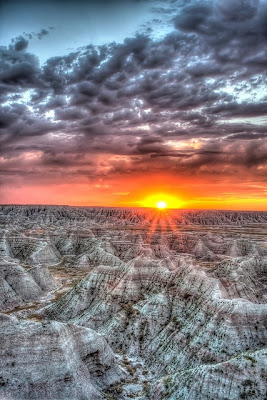A spectacular sunrise in Badlands National Park.
Image credit: http://pinterest.com/pin/24699497927572277/
Because the Badlands have eroded so much there are steep slopes and lots of loose earth, both of which are conducive to landslides. One area in which these landslides have been fairly large and have affected people is along the Norbeck Pass which is in the Eastern part of the National Park. Here there have been several landslides which have blocked the road and caused costly repairs to the road.
Norbeck Pass where landslides have occurred and blocked the road.
Image credit: http://www.takemytrip.com/08wyo/08n_34a.htm
Badlands National Park is a very dry place getting only about sixteen inches of precipitation a year, which is very similar to that of Denver’s annual precipitation. But the majority of the precipitation that falls in the Badlands is in the form of rain, which is more damaging than snow and results in many gullies and rills. The landscape of the Badlands is riddled with these water channels formed by overland flow of water and they contribute to the erosion that is happening there.
Gullies eroded into ridges in Badlands National Park.
Much of the soil found in the Badlands National Park is Paleosols, which is ancient soil usually buried beneath layers of rock or more recent soil horizons. There is a large amount of fossil evidence and organic matter in this soil, which is from the vast amounts of living organisms that used to live in this region when it had a semi-tropical climate, around fifty million years ago. The reason that Paleosols is the common soil found is that the rocks and new soil horizons have eroded away over time.
Image of soil horizons found in Badlands National Park.
Image credit: http://picasaweb.google.com/lh/photo/D40lTy48oYh8r04fwtvKfg
Image credit: http://picasaweb.google.com/lh/photo/D40lTy48oYh8r04fwtvKfg




No comments:
Post a Comment